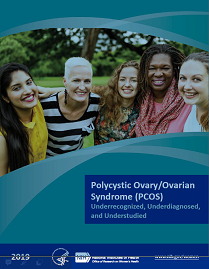
PCOS results from high levels of hormones called androgens and can cause male-pattern hair growth, acne, irregular menstrual cycles, and ovarian cysts. PCOS can also lead to insulin resistance, obesity, and cardiovascular disease. PCOS is the most common endocrine disease among women. Although the syndrome may affect as many as 26% of women, 50% of PCOS cases remain undiagnosed or are misdiagnosed, in part because of changing definitions of the disease and its heterogeneous symptoms and progression.
As part of the observation of PCOS Awareness Month (September), ORWH developed an informative PCOS booklet to educate and improve understanding and diagnosis of this syndrome.
The PCOS booklet informs women about their chances of having PCOS, suggests how to manage symptoms, and describes how the syndrome affects women across their life course.
The booklet also describes the cause and symptoms of PCOS, NIH initiatives related to the disease, and the different definitions established by NIH, the European Society of Human Reproduction and Embryology, the American Society for Reproductive Medicine, and the Androgen Excess and PCOS Society.
Access the booklet here.
